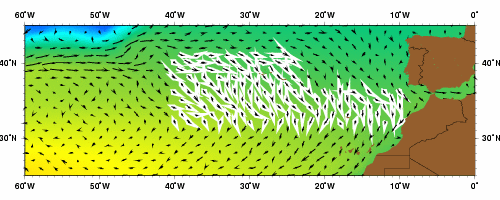
| ||
| The Azores current as represented by the Mariano Global Surface Velocity Analysis (MGSVA). The Azores current is the southeastward flow component of the North Atlantic subtropical gyre. The southernmost highlighted velocities are also known as the Portugal Current. Click here for example plots of seasonal averages. | ||
Along its eastward-flowing component, the Azores Current produces three major southward-flowing branches (Klein and Siedler 1989). The easternmost branch turns southwards to feed the Canary Current (New et al. 2001; Stramma 1984). The two other branches join the westward-flowing North Equatorial Current (Maillard and Käse 1989). One can be found between about 23°W and 27°W. The other can be found between about 32°W and 36°W. Their exact location varies seasonally and interannually (Klein and Siedler 1989).
The main Azores current jet is about 150 km wide and 1000 m deep. Strong thermohaline gradients are characteristic of the area. Near 34.5°N between 20°W and 30°W the average current speed is about 10 cm s-1. Drogued buoys have obtained speeds of 50 cm s-1 in this area, while in the nearby counterflows they can reach 40 cm s-1 (Pingree 1997).
Most investigations of the Azores Current have found its transport to be 10-12 Sv (Gould 1985; Kät;se et al. 1986; Sy 1988; Stramma and Muller 1989). An exception is Pingree (1997), who reported a geostrophic transport of 26 Sv near 27°W. Although this was the transport for the main current jet, most of it was cancelled by adjacent countercurrents. Pingree et al. (1999) observed a 10 Sv eastward geostrophic transport for the region across 30.5°N-36.5°N near 25°W-30°W, but the total southward transport across 20°W-50°W was 28 Sv.
Cromwell et al. (1996) observed a persistent westward flow near 35°N, 28°W that travelled at 25 cm s-1. They found that this westward flow was cooler and fresher than the main body of the Azores Current and thus concluded that it was caused by the retroflection of the cooler, northern side of the current. Pingree (1997) examined Lagrangian data and water mass properties and showed that the Azores Current recirculates both north and south in westward counterflows. There is anticlockwise circulation in the north and clockwise circulation in the south.
The area near the Azores Current has high eddy kinetic energy, with the scale of dominant wavelengths around 300-400 km and the mean diameter of eddies on the order of 100 km (Le Traon and De Mey, 1994). Meanders with the longest wavelengths are presumably due to Rossby waves, and those with shorter wavelengths are due to interactions with the mesoscale eddy fields (Johnson and Stevens 2000). Klein and Siedler (1989) found that during the summer the Azores Current narrows, moves farther south, and experiences more mesoscale variability. In contrast, Tokmakian and Challenor (1993) learned that overall the mesoscale variability is slightly higher in the winter than in the summer. However, in the region between 30°N and 40°N the summer has the highest variability. Cromwell et al. (1996) also found that the variability increases from summer to winter. They point out that the contradictions among these data sets could be due to interannual variability.